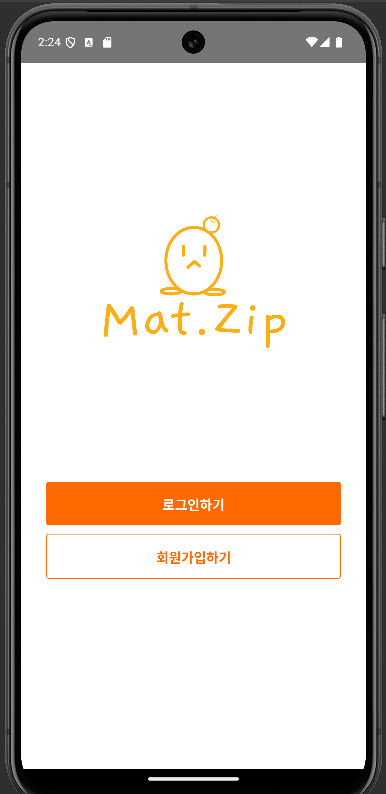맛집 앱 만들기 프로젝트 Part8 홈 스크린 및 Input컴포넌트 구현하기
최초 화면에 로고를 표시하기 위해 로고 파일 넣기
[matzip/front/src/assets/matzip.png] 해당 경로로 폴더 및 로고파일 넣어주도록하자
[matzip/front/src/screens/AuthHomeScreen.tsx] 파일 코드를 수정하자
- 20번째 줄에 react-native에서 기본으로 제공하는 Image 컴포넌트를 사용해서 로고를 불러오도록하였다 resizeMode 옵션으로 contain을 주어 이미지의 가로 세로 비율을 유지한 상태로 이미지를 리사이징하며 이미지의 모든 영역이 뷰 안에 보이게하도록 하였다 style은 하단에 따로 지정하도록했다 source는 로고 경로
1
2
3
4
5
6
7
8
9
10
11
12
13
14
15
16
17
18
19
20
21
22
23
24
25
26
27
28
29
30
31
32
33
34
35
36
37
38
39
40
41
42
43
44
45
46
47
48
49
50
51
52
53
54
55
56
57
58
59
60
61
62
import {StackScreenProps} from '@react-navigation/stack';
import React from 'react';
import {
Button,
Dimensions,
Image,
SafeAreaView,
StyleSheet,
View,
} from 'react-native';
import {AuthStackParamList} from '../../navigations/stack/AuthStackNavigator';
import {authNavigations} from '../../constants/navigations';
import CustomButton from '../../components/CustomButton';
type AuthHomeScreenProps = StackScreenProps<AuthStackParamList>;
function AuthHomeScreen({navigation}: AuthHomeScreenProps) {
return (
<SafeAreaView style={styles.container}>
<View style={styles.imageContainer}>
<Image
resizeMode="contain"
style={styles.image}
source={require('../../assets/matzip.png')}
/>
</View>
<View style={styles.buttonContainer}>
<CustomButton
label="로그인하기"
onPress={() => navigation.navigate(authNavigations.LOGIN)}
/>
<CustomButton
label="회원가입하기"
variant="outlined"
onPress={() => navigation.navigate(authNavigations.SIGNUP)}
/>
</View>
</SafeAreaView>
);
}
const styles = StyleSheet.create({
container: {
flex: 1,
margin: 30,
alignItems: 'center',
},
imageContainer: {
flex: 1.5,
width: Dimensions.get('screen').width / 2,
},
image: {
width: '100%',
height: '100%',
},
buttonContainer: {
flex: 1,
gap: 10,
},
});
export default AuthHomeScreen;
InputField 컴포넌트 구현하기
[matzip/front/src/components/InputField.tsx]
로그인 및 회원가입 페이지 외에도 입력받는 창을 중복적으로 사용하게될텐데 해당 입력 창을 컴포넌트로 작성하여 쉽게 불러와서 사용할 수 있도록 하려고 한다
먼저 입력 창 InputField 컴포넌트 코드를 작성해보도록 한다
1
2
3
4
5
6
7
8
9
10
11
12
13
14
15
16
17
18
19
20
21
22
23
24
25
26
27
28
29
30
31
32
33
34
35
36
37
38
39
40
41
42
43
44
45
46
47
48
49
50
51
52
53
54
55
56
57
58
59
60
61
62
63
64
65
66
67
68
69
70
71
72
73
74
75
76
77
78
79
80
81
82
83
84
import React, {useRef} from 'react';
import {
Dimensions,
Pressable,
StyleSheet,
Text,
TextInput,
TextInputProps,
View,
} from 'react-native';
import {colors} from '../constants';
// TextInputProps를 확장하여 props를 넘겨받아서 사용할 수 있도록하자
interface InputFieldProps extends TextInputProps {
disabled?: boolean;
error?: string;
touched?: boolean;
}
const deviceHeight = Dimensions.get('screen').height;
const InputField = ({
disabled = false,
error,
touched,
...props
}: InputFieldProps) => {
// 입력창 포커스를 조금 더 정확하게 잡기위해 (주변 클릭해도 입력창으로갈 수 있게) useRef를 활용
const innerRef = useRef<TextInput | null>(null);
const handlePressInput = () => {
innerRef.current?.focus();
};
return (
<Pressable onPress={handlePressInput}>
<View
style={[
styles.container,
disabled && styles.disabled,
touched && Boolean(error) && styles.inputError,
]}>
<TextInput
editable={!disabled}
placeholderTextColor={colors.GRAY_500}
style={[styles.input, disabled && styles.disabled]}
autoCapitalize="none"
spellCheck={false}
autoCorrect={false}
{...props}
/>
// error변수의 데이터를 확인하여 값이 없으면 안보여주고 값이있고 touche된 상태면 에러를 보여준다
{touched && Boolean(error) && <Text style={styles.error}>{error}</Text>}
</View>
</Pressable>
);
};
const styles = StyleSheet.create({
container: {
borderWidth: 1,
borderColor: colors.GRAY_200,
padding: deviceHeight > 700 ? 15 : 10,
},
input: {
fontSize: 16,
color: colors.BLACK,
padding: 0,
},
disabled: {
backgroundColor: colors.GRAY_200,
color: colors.GRAY_700,
},
inputError: {
borderWidth: 1,
borderColor: colors.RED_300,
},
error: {
color: colors.RED_500,
fontSize: 12,
paddingTop: 5,
},
});
export default InputField;
LoginScreen 파일 코드 작성
[matzip/front/src/screens/LoginScreen.tsx]
위에서 만들어둔 InputField 컴포넌트를 불러와서 입력창을 만들도록한다
1
2
3
4
5
6
7
8
9
10
11
12
13
14
15
16
17
18
19
20
21
22
23
24
25
26
27
28
29
30
31
32
33
34
35
36
37
38
39
40
41
42
43
44
45
46
47
48
49
50
51
52
53
54
55
56
57
58
59
60
61
62
63
64
65
66
67
68
69
70
71
72
73
74
75
76
77
78
79
80
81
82
83
import React, {useState} from 'react';
import {SafeAreaView, StyleSheet, Text, TextInput, View} from 'react-native';
import InputField from '../../components/InputField';
function LoginScreen() {
// const [email, setEmail] = useState('');
// const [password, setPassword] = useState('');
// const handleChangeEmail = (text: string) => {
// setEmail(text);
// };
// const handleChangePassword = (text: string) => {
// setPassword(text);
// };
// 사용자로부터 입력받은 이메일,비밀번호 데이터를 담기 위한 state지정(바로 위에 주석 코드에서는 이메일 패스워드를 따로 따로 받았지만 코드를 리팩토링하여 하나의 객체로 받음)
const [values, setValues] = useState({
email: '',
password: '',
});
// 사용자가 터치를 했는지 안했는지에 따라 이벤트를 다르게하기위해 state를지정함
const [touched, setTouched] = useState({
email: false,
password: false,
});
// 사용자가 입력할때마다 데이터를 state로 넘겨주기 위함
const handleChangeText = (name: string, text: string) => {
setValues({
...values,
[name]: text,
});
};
// 이메일 혹은 비밀번호 데이터가 정규식에 적합한지 확인하기위해 엔터 혹은 해당 focus를 떠났을때를 감지하는 blur이벤트 핸들러를 만들어서 touched에 값을 넣어주었다
const handleBlur = (name: string) => {
setTouched({
...touched,
[name]: true,
});
};
return (
<SafeAreaView style={styles.container}>
<View style={styles.inputContainer}>
<InputField
placeholder="이메일"
error={'이메일을 입력하세요'}
touched={touched.email}
inputMode="email"
value={values.email}
onChangeText={text => handleChangeText('email', text)}
onBlur={() => handleBlur('email')}
/>
<InputField
placeholder="비밀번호"
error={'비밀번호를 입력하세요'}
touched={touched.password}
secureTextEntry
value={values.password}
onChangeText={text => handleChangeText('password', text)}
onBlur={() => handleBlur('password')}
/>
</View>
</SafeAreaView>
);
}
const styles = StyleSheet.create({
container: {
flex: 1,
margin: 30,
},
inputContainer: {
gap: 20,
},
});
export default LoginScreen;
This post is licensed under
CC BY 4.0
by the author.
